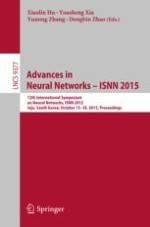2015 | Buch
Advances in Neural Networks – ISNN 2015
12th International Symposium on Neural Networks, ISNN 2015, Jeju, South Korea, October 15-18, 2015, Proceedings
herausgegeben von: Xiaolin Hu, Yousheng Xia, Yunong Zhang, Dongbin Zhao
Verlag: Springer International Publishing
Buchreihe : Lecture Notes in Computer Science
